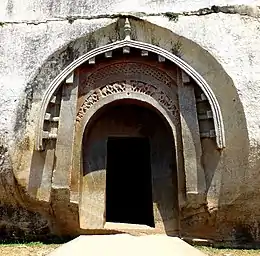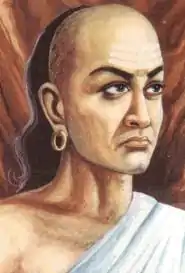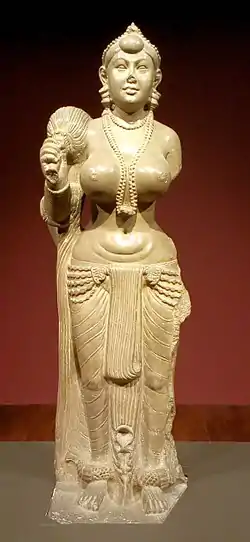Chandragupta Maurya
Chandragupta Maurya (reign: 321–297 BCE) was the founder of the Maurya Empire in ancient India. He was taught and counselled by the philosopher Chanakya, who had great influence in the formation of his empire. Together, Chandragupta and Chanakya built one of the largest empires on the Indian subcontinent. Chandragupta's life and accomplishments are described in ancient Greek, Hindu, Buddhist and Jain texts, but they vary significantly. In Ancient Greek and Latin accounts, Chandragupta is referred as Sandrokottos or Androcottus.
| Chandragupta Maurya | |
|---|---|
| Piadamsana | |
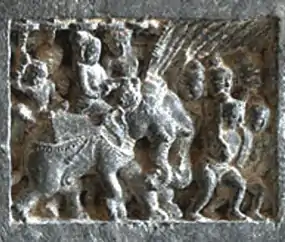 Medieval stone relief at Digambara pilgrimage site Shravanabelagola, Karnataka. It has been interpreted as Bhadrabahu and Chandragupta Maurya,[1] but some disagree.[2] | |
| 1st Mauryan Emperor | |
| Reign | c. 324 or 321 – c. 297 BCE[3][4] |
| Coronation | c. 324 or 321 BCE |
| Predecessor | Dhana Nanda |
| Successor | Bindusara (son)[5] |
| Spouses | Durdhara (according to Jain tradition) Helena Nandani |
| Issue | Bindusara |
| Dynasty | Maurya |
| Father | Suryagupta |
| Mother | Mura |
| Religion | |
| Maurya Empire (322–180 BCE) | ||||||||||||||||||||
|---|---|---|---|---|---|---|---|---|---|---|---|---|---|---|---|---|---|---|---|---|
|
||||||||||||||||||||
Chandragupta Maurya was a pivotal figure in the history of India, laying the foundations of the first government to unite most of South Asia. Chandragupta, under the tutelage of Chanakya, created a new empire based on the principles of statecraft, built a large army, and continued expanding the boundaries of his empire until ultimately renouncing it for an ascetic life in his final years.
Prior to his consolidation of power, Alexander the Great had invaded the North-West Indian subcontinent before abandoning his campaign in 324 BCE due to a mutiny caused by the prospect of facing another large empire, presumably the Nanda Empire. Chandragupta defeated and conquered both the Nanda Empire, and the Greek satraps that were appointed or formed from Alexander's Empire in South Asia. Chandragupta first gained regional prominence in the Greater Punjab region in the Indus. He then set out to conquer the Nanda Empire centered in Pataliputra, Magadha. Afterwards, Chandragupta expanded and secured his western border, where he was confronted by Seleucus I Nicator in the Seleucid-Mauryan War. After two years of war, Chandragupta was considered to have gained the upper hand in the conflict and annexed satrapies up to the Hindu Kush. Instead of prolonging the war, both parties settled on a marriage alliance between Chandragupta and the daughter of Seleucus I Nicator instead.
Chandragupta's empire extended throughout most of the Indian subcontinent, spanning from modern day Bengal to Afghanistan across North India. As well as making inlays into Central and South India. According to historical Jain accounts, Chandragupta would renounce his throne to become a Jain monk, and would travel away from his empire to South India and committed sallekhana or fasting to death. Chandragupta's's reign, and the Maurya Empire, set an era of economic prosperity, reforms, infrastructure expansions, and tolerance. Many religions thrived within his realms and his descendants' empire. Buddhism, Jainism and Ajivika gained prominence alongside Vedic and Brahmanistic traditions, and minority religions such as Zoroastrianism and the Greek pantheon were respected. A memorial for Chandragupta Maurya exists on the Chandragiri hill along with a 7th-century hagiographic inscription.
Biography
Chandragupta's life and accomplishments are described in ancient and historical Greek, Hindu, Buddhist and Jain texts, though they significantly vary in detail.[8] The historical sources which describe the life of Chandragupta Maurya vary considerably in details. His main biographical sources in chronological order are:[9]
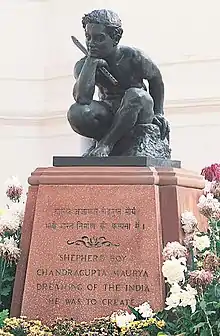
- Greek and Roman sources, which are the oldest surviving records that mention Chandragupta or circumstances related to him; these include works written by Nearchus, Onesicritus, Aristobulus of Cassandreia, Strabo, Megasthenes, Diodorus, Arrian, Pliny the Elder, Plutarch and Justin.
- Hindu texts such as the Puranas and Arthashastra; later composed Hindu sources include legends in Vishakhadatta's Mudrarakshasa, Somadeva's Kathasaritsagara and Kshemendra's Brihatkathamanjari.
- Buddhist sources are those dated in 4th-century or after, including the Sri Lankan Pali texts Dipavamsa (Rajavamsa section), Mahavamsa, Mahavamsa tika and Mahabodhivamsa.
- 7th to 10th century Jain inscriptions at Shravanabelgola; these are disputed by scholars as well as the Svetambara Jain tradition.[10][11] The second Digambara text interpreted to be mentioning the Maurya emperor are dated to about the 10th-century such as in the Brhatkathakosa of Harisena (Jain monk), while the complete Jain legend about Chandragupta is found in the 12th-century Parisishtaparvan by Hemachandra.
The Greek and Roman texts do not mention Chandragupta directly, except for a 2nd-century text written by the Roman historian Justin. They predominantly mention the last Nanda Empire, who usurped the king before him. Justin states Chandragupta was of humble origin and includes stories of miraculous legends associated with him, such as a wild elephant appearing and submitting itself as a ride to him before a war. Justin's text notes Chandragupta and Chanakya defeated and removed Nanda from his rule.[12] Megasthenes' account, as it has survived in Greek texts that quote him, states that Alexander the Great and Chandragupta met, which if true would mean his rule started earlier than 321 BCE. He is described as a great king, but not as great in power and influence as Porus in northwestern India or Agrammes (Dhana Nanda) in eastern India.[13]
The pre-4th century Hindu Puranic texts mostly mirror the Greek sources. These texts do not discuss the details of Chandragupta's ancestry, but rather cover the ancestry of the last Nanda king. The Nanda king is described to be cruel, against dharma and shastras, and born out of an illicit relationship followed by a coup.[14] The Chanakya's Arthasastra refers to the Nanda rule as against the spiritual, cultural and military interests of the country, a period where intrigue and vice multiplied.[14] Chanakya states that Chandragupta returned dharma, nurtured a diversity of views and ruled virtuously that kindled love among the subjects for his rule.[14]
Hindu sources are inconsistent. One medieval commentator states Chandragupta to be the son of one of the Nanda's wives with the name Mura.[14] Other sources describe Mura as a concubine of the king.[15] Another Sanskrit dramatic text Mudrarakshasa uses the terms Vrishala and Kula-hina to describe Chandragupta.[16] The word Vrishala has two meanings: one is the son of a Shudra; the other means the best of kings. A later commentator used the former interpretation to posit that Chandragupta had a Shudra background. However, historian Radha Kumud Mukherjee opposed this theory, and stated that the word should be interpreted as "the best of kings”.[16] The same drama also refers to Chandragupta as someone of humble origin, in a manner similar to Justin.[16] According to the 11th century texts of the Kashmiri Hindu tradition – Kathasaritsagara and Brihat-Katha-Manjari – the Nanda lineage was very short. Chandragupta was a son of Purva-Nanda, the older Nanda based in Ayodhya.[17][18][19] The common theme in the Hindu sources is that Chandragupta came from a humble background and with Chanakya he emerged as a dharmic king loved by his subjects.[20]
The Buddhist texts such as Mahavamsa describe Chandragupta to be of Kshatriya origin.[21] These sources, written about seven centuries after his dynasty ended, state that both Chandragupta and his grandson Ashoka – a patron of Buddhism – were from a branch of the Shakya noble family, from which Gautama Buddha descended from.[22] These Buddhist sources attempt to link the dynasty of their patron Ashoka directly to the Buddha.[23] The sources claim that the family branched off to escape persecution from a king of the Kosala Kingdom and Chandragupta's ancestors moved into a secluded Himalayan kingdom known for its peacocks. The Buddhist sources explain the epithet Moriya comes from these peacocks, or Mora in Pali (Sanskrit: Mayura).[22][3] The Buddhist texts are inconsistent; some offer other legends to explain his epithet. For example, they mention a city named "Moriya-nagara" where all buildings were made of bricks colored like the peacock's neck.[24] The Maha-bodhi-vamsa states he hailed from Moriya-nagara, while the Digha-Nikaya states he came from the Moriya clan of Pipphalivana.[21] The Buddhist sources also mention that “Brahmin Chanakya” was his counselor and with whose support Chandragupta became the king at Patliputra.[24]
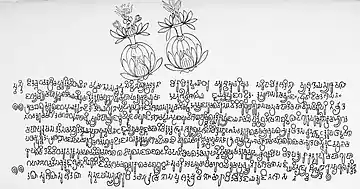
The 12th-century Digambara text Parishishtaparvan by Hemachandra is the main and earliest Jain source of the complete legend of Chandragupta. It was written nearly 1,400 years after Chandragupta's death. In Canto 8, verses 170 to 469, it describes the legend of Chandragupta and Chanakya's influence on him.[21][25] Other Digambara Jain sources state he moved to Karnataka after renouncing his kingdom and performed Sallekhana – the Jain religious ritual of peacefully welcoming death by fasting.[26][27] The earliest mention of Chandragupta's ritual death is found in Harisena's Brhatkathakosa, a Sanskrit text of stories about Digambara Jains. The Brhatkathakosa describes the legend of Bhadrabahu and mentions Chandragupta in its 131st story.[28] However, the story makes no mention of the Maurya empire, and mentions that his disciple Chandragupta lived in and migrated from Ujjain – a kingdom (northwest Madhya Pradesh) about a thousand kilometers west of the Magadha and Patliputra (central Bihar). This has led to the proposal that Harisena's Chandragupta may be a later era, different person.[28][2][29]
Date
None of the ancient texts mention when Chandragupta was born. Plutarch claims that he was a young man when he met Alexander during the latter's invasion of India (c. 326-325 BCE). Assuming the Plutarch account is true, Raychaudhuri proposed in 1923 that Chandragupta may have been born after 350 BCE.[30] According to other Greco-Roman texts, Chandragupta attacked the Greek-Indian governors after Alexander's death (c. 323 CE) with Seleucus I Nicator entering into a treaty with Chandragupta years later.[31] Seleucus Nicator, under this treaty, gave up Arachosia (Kandahar), Gedrosia (Makran) and Paropanisadai (Paropamisadae, Kabul) to Chandragupta, in exchange for 500 war elephants.[13]
The texts do not include the start or end year of Chandragupta's reign.[32] According to some Hindu and the Buddhist texts, Chandragupta ruled for 24 years.[33] The Buddhist sources state Chandragupta Maurya ruled 162 years after the death of the Buddha.[34] However, the Buddha's birth and death varies by source and all these lead to a chronology that is significantly different than the Greek-Roman records. Similarly, Jain sources composed give different gaps between Mahavira's death and his accession.[34] As with the Buddha's death, the date of Mahavira's death itself is also a matter of debate, and the inconsistencies and lack of unanimity among the Jain authors casts doubt on Jain sources. This Digambara Jain chronology, in addition, is not reconcilable with the chronology implied in other Indian and non-Indian sources.[34]
Historians such as Irfan Habib and Vivekanand Jha assign Chandragupta's reign to c. 322-298 BCE.[35] Upinder Singh dates his rule from 324 or 321 BCE to 297 BCE.[5] Kristi Wiley states he reigned between 320 and 293 BCE.[10] D D Kosambi writes that some of Chandragupta's coin-legends prove him to be a Hindu ruler.[36] Chandragupta is noted to be the earliest Hindu ruler whose inscribed gold coins have been found.[7]
Early life
The early life of Chandragupta Maurya is unclear and varies by source. According to the Sinhalese Buddhist tradition, Chandragupta's mother was pregnant when his father - who was the chief of the Moriya clan - was killed in a battle. His mother escaped to Patliputra with the help of her brothers. For Chandragupta's safety, his maternal uncles helped a cowherd adopt him. When Chandragupta grew up, the cowherd sold him to a hunter who employed him to tend cattle.[37][38]
According to the Digambara legend by Hemachandra, Chanakya was a Jain layperson and a Brahmin. When Chanakya was born, Jain monks prophesied that Chanakya will one day grow up to help make someone an emperor and will be the power behind the throne.[39][25] Chanakya believed in the prophecy and fulfilled it by agreeing to help the daughter of a peacock breeding community chief deliver a baby boy. In exchange, he asked the mother to give up the boy and let him adopt him at a later date.[21][25] The Jain Brahmin then went about making money through magic, and returned later to claim young Chandragupta,[25] whom he taught and trained. Together, they recruited soldiers and attacked the Nanda kingdom. Eventually, they won and proclaimed Patliputra as their capital.[25]
Career
Influence of Chanakya (Kautilya)
The Buddhist and Hindu sources present different versions of how Chandragupta met Chanakya. Broadly, they mention young Chandragupta creating a mock game of a royal court that he and his cowherd friends played. Chanakya saw him give orders to the others, bought him from the hunter, and adopted Chandragupta.[40] Chanakya taught and admitted him in Taxila to study the Vedas, military arts, law, and other sastras.[40][41]
After Taxila, Chandragupta and Chanakya moved to Patliputra, the capital and a historic learning center in the eastern Magadha kingdom of India. They met Nanda there according to Hindu sources, and Dhana Nanda according to Pali-language Buddhist sources.[42] Chandragupta became a commander of the Nanda army, but according to Justin, Chandragupta offended the Nanda king ("Nandrum" or "Nandrus") who ordered his execution.[39] An alternate version states that it was the Nanda king who was publicly insulted by Chanakya.[43] Chandragupta and Chanakya escaped and became rebels who planned to remove the Nanda king from power.[44][note 1] The Mudrarakshasa also states that Chanakya swore to destroy the Nanda dynasty after he felt insulted by the king.[43]
The Roman text by Justin mentions a couple of miraculous incidents that involved Sandracottus (Chandragupta) and presents these legends as omens and portents of his fate. In the first incident, when Chandragupta was asleep after having escaped from Nandrum, a big lion came up to him, licked him, and then left. In the second incident, when Chandragupta was readying for war with Alexander's generals, a huge wild elephant approached him and offered itself to be his steed.[46]
Building the empire
According to the Buddhist text Mahavamsa Tika, Chandragupta and Chanakya raised an army by recruiting soldiers from many places after the former completed his education at Taxila. Chanakya made Chandragupta the leader of the army.[47] The Digambara Jain text Parishishtaparvan states that this army was raised by Chanakya with coins he minted and an alliance formed with Parvataka.[48][49] According to Justin, Chandragupta organized an army. Early translators interpreted Justin's original expression as "body of robbers", but states Raychaudhuri, the original expression used by Justin may mean mercenary soldier, hunter, or robber.[50]
The Buddhist Mahavamsa Tika and Jain Parishishtaparvan records Chandragupta's army unsuccessfully attacking the Nanda capital. [48] Chandragupta and Chanakya then began a campaign at the frontier of the Nanda empire, gradually conquering various territories on their way to the Nanda capital.[51] He then refined his strategy by establishing garrisons in the conquered territories, and finally besieged the Nanda capital Pataliputra. There Dhana Nanda accepted defeat, and was killed by Buddhist accounts,[52] or deposed and exiled by Hindu accounts.[53]
Conquest of the Nanda empire
Greco-Roman writer Plutarch stated, in his Life of Alexander, that the Nanda king was so unpopular that had Alexander tried, he could have easily conquered India.[44][54] After Alexander ended his campaign and left, Chandragupta's army conquered the Nanda capital Pataliputra around 322 BCE with Chanakya's counsel.[39]
Historically reliable details of Chandragupta's campaign into Pataliputra are unavailable and legends written centuries later are inconsistent. Buddhist texts such as Milindapanha claim Magadha was ruled by the Nanda dynasty, which, with Chanakya's counsel, Chandragupta conquered to restore dhamma.[55][56] The army of Chandragupta and Chanakya first conquered the Nanda outer territories before invading Pataliputra. In contrast to the easy victory in Buddhist sources, the Hindu and Jain texts state that the campaign was bitterly fought because the Nanda dynasty had a powerful and well-trained army.[57][56]
The conquest was fictionalised in Mudrarakshasa, in which Chandragupta is said to have first acquired Punjab and allied with a local king named Parvatka under the Chanakya's advice before advancing on the Nanda Empire.[58] Chandragupta laid siege to Kusumapura (now Patna), the capital of Magadha, by deploying guerrilla warfare methods with the help of mercenaries from conquered areas.[59][60] Historian P. K. Bhattacharyya states that the empire was built by a gradual conquest of provinces after the initial consolidation of Magadha.[61]
According to the Digambara Jain version by Hemachandra, the success of Chandragupta and his strategist Chanakya was stopped by a Nanda town that refused to surrender.[62] Chanakya disguised himself as a mendicant and found seven mother goddesses (saptamatrika) inside. He concluded these goddesses were protecting the town people.[62] The townspeople sought the disguised mendicant's advice on how to end the blockade of the army surrounding their town. Hemacandra wrote Chanakya swindled them into removing the mother goddesses. The townspeople removed the protective goddesses and an easy victory over the town followed. Thereafter, the alliance of Chandragupta and Parvataka overran the Nanda kingdom and attacked Patliputra with an "immeasurable army".[62] With a depleted treasury, exhausted merit, and insufficient intelligence, the Nanda king lost.[62]
These legends state that the Nanda king was defeated, but allowed to leave Pataliputra alive with a chariot full of items his family needed.[63] The Jain sources attest that his daughter fell in love at first sight with Chandragupta and married him.[62][21] With the defeat of Nanda, Chandragupta Maurya founded the Maurya Empire in ancient India.[3][64]
Conquest of north-west regions

The Indian campaign of Alexander the Great ended before Chandragupta came into power. Alexander had left India in 325 BCE and assigned the northwestern Indian subcontinent territories to Greek governors.[65][66] The nature of early relationship between these governors and Chandragupta is unknown. Justin mentions Chandragupta as a rival of the Alexander's successors in north-western India.[35] He states that after Alexander's death, Chandragupta freed Indian territories from the Greeks and executed some of the governors.[67] According to Boesche, this war with the northwestern territories were in part fought by mercenaries hired by Chandragupta and Chanakya, and these wars may have been the cause of the demise of two of Alexander's governors, Nicanor and Philip.[68] Megasthenes served as a Greek ambassador in his court for four years.[64]
War and marriage alliance with Seleucus
According to Appian, Seleucus I Nicator, one of Alexander's Macedonian generals who in 312 BCE established the Seleucid Kingdom with its capital at Babylon, brought Persia and Bactria under his own authority, putting his eastern front facing the empire of Chandragupta.[69][70] Seleucus and Chandragupta waged war until they came to an understanding with each other. Seleucus married off his daughter to Chandragupta to forge an alliance.[70]
R. C. Majumdar and D. D. Kosambi note that Seleucus appeared to have fared poorly after ceding large territories west of the Indus to Chandragupta. The Maurya Empire added Arachosia (Kandahar), Gedrosia (Balochistan), and Paropamisadae (Gandhara).[71][72][lower-alpha 1] According to Strabo, Seleucus Nicator gave these regions to Chandragupta along with a marriage treaty, and in return received five hundred elephants.[73] The details of the engagement treaty are not known.[74] According to one version, the marriage treaty involved an Indian princess, while a different version states a Seleucid princess married into the Mauryan family.[75]
Chandragupta sent 500 war elephants to Seleucus, which played a key role in Seleucus' victory at the Battle of Ipsus.[76][77][78] In addition to this treaty, Seleucus dispatched Megasthenes as an ambassador to Chandragupta's court, and later Antiochos sent Deimakos to his son Bindusara at the Maurya court at Patna.[79]
Southern conquest
After annexing Seleucus' provinces west of the Indus river, Chandragupta had a vast empire extending across the northern Indian sub-continent from the Bay of Bengal to the Arabian Sea. Chandragupta began expanding his empire southwards beyond the Vindhya Range and into the Deccan Plateau.[39] By the time his conquests were complete, Chandragupta's empire extended over most of the subcontinent.[80]
Two poetic anthologies from the Tamil Sangam literature corpus – Akananuru and Purananuru – allude to the Nanda rule and Maurya empire. For example, poems 69, 281 and 375 mention the army and chariots of the Mauryas, while poems 251 and 265 may be alluding to the Nandas.[81] However, the poems dated between 1st-century BCE to 5th-century CE do not mention Chandragupta Maurya by name, and some of them could be referring to a different Moriya dynasty in the Deccan region in the 5th century CE.[82] According to Upinder Singh, these poems may be mentioning Mokur and Koshar kingdoms of Vadugars (northerners) in Karnataka and Andhra Pradesh, with one interpretation being that the Maurya empire had an alliance with these at some point of time.[83]
Names and titles
_(cropped).JPG.webp)
Greek writer Phylarchus (c. 3rd century BCE), who is quoted by Athenaeus, calls Chandragupta "Sandrokoptos". The later Greco-Roman writers Strabo, Arrian, and Justin (c. 2nd century) call him "Sandrocottus".[84] In Greek and Latin accounts, Chandragupta is known as Sandrakottos (Greek: Σανδράκοττος) and Androcottus (Greek: Ανδροκόττος).[85][86] However, some recent authors have disputed the identification of "Sandrokottus" of Greek accounts with Chandragupta Maurya.[87][88]
The king's epithets mentioned in the Sanskrit play Mudrarakshasa include "Chanda-siri" (Chandra-shri), "Piadamsana" (Priya-darshana), and Vrishala.[84] Piadamsana is similar to Piyadasi, an epithet of his grandson Ashoka.[89] The word "Vrishala" is used in Indian epics and law books to refer to non-orthodox people. According to one theory, it may be derived from the Greek royal title Basileus, but there is no concrete evidence of this: the Indian sources apply it to several non-royals, especially wandering teachers and ascetics.[90]
Empire
There are no records of Chandragupta's military conquests and the reach of his empire. It is based on inferences from Greek and Roman historians and the religious Indian texts written centuries after his death. Based on these, the North-West reach of his empire included parts of present-day Afghanistan that Seleucus I Nicator ceded to him including Kabul, Kandahar, Taxila and Gandhara.[71][91] These are the areas where his grandson Ashoka left the major Kandahar rock edict and other edicts in the Greek and Aramaic languages.[92][93]
In the west, Chandragupta's rule over present-day Gujarat is attested to by Ashoka's inscription in Junagadh. On the same rock, about 400 years later, Rudradaman inscribed a longer text sometime about the mid 2nd–century.[94] Rudradaman's inscription states that the Sudarshana lake in the area was commissioned during the rule of Chandragupta through his governor Vaishya Pushyagupta and conduits were added during Ashoka's rule through Tushaspha. The Mauryan control of the region is further corroborated by the inscription on the rock, which suggests that Chandragupta controlled the Malwa region in Central India, located between Gujarat and Pataliputra.[95]
There is uncertainty about the other conquests that Chandragupta may have achieved, especially in the Deccan region of southern India.[95] At the time of his grandson Ashoka's ascension in c. 268 BCE, the empire extended up to present-day Karnataka in the south, so the southern conquests may be attributed to either Chandragupta or his son Bindusara. If the Jain tradition about Chandragupta ending his life as a renunciate in Karnakata is considered correct, it appears that Chandragupta initiated the southern conquest.[96]
Maurya with his counsellor Chanakya together built one of the largest empires ever on the Indian subcontinent.[3][27][97] Chandragupta's empire extended from Bengal to central Afghanistan encompassing most of the Indian subcontinent except for parts that are now Tamil Nadu, Kerala and Odisha.[98][27]
Rule
After unifying much of India, Chandragupta and Chanakya passed a series of major economic and political reforms. Chandragupta established a strong central administration from Pataliputra (now Patna).[99] Chandragupta applied the statecraft and economic policies described in Chanakya's text Arthashastra.[100][101][102] There are varying accounts in the historic, legendary, and hagiographic literature of various Indian religions about Chandragupta's rule, but Allchin and Erdosy' are suspect; they state, "one cannot but be struck by the many close correspondences between the (Hindu) Arthashastra and the two other major sources the (Buddhist) Asokan inscriptions and (Greek) Megasthenes text".[103]
The Maurya rule was a structured administration; Chandragupta had a council of ministers (amatya), with Chanakya was his chief minister.[104][105] The empire was organised into territories (janapada), centres of regional power were protected with forts (durga), and state operations were funded with treasury (kosa).[106] Strabo, in his Geographica composed about 300 years after Chandragupta's death, describes aspects of his rule in his chapter XV.46–69. He had councillors for matters of justice and assessors to collect taxes on commercial activity and trade goods. He routinely performed Vedic sacrifices,[107] Brahmanical rituals,[108] and hosted major festivals marked by procession of elephants and horses. His officers inspected situations requiring law and order in the cities; the crime rate was low.[109]
According to Megasthenes, Chandragupta's rule was marked by three parallel administrative structures. One managed the affairs of villages, ensuring irrigation, recording land ownership, monitoring tools supply, enforcing hunting, wood products and forest-related laws, and settling disputes.[110] Another administrative structure managed city affairs, including all matters related to trade, merchant activity, visit of foreigners, harbors, roads, temples, markets, and industries. They also collected taxes and ensured standardized weights and measures.[110] The third administrative body overlooked the military, its training, its weapons supply, and the needs of the soldiers.[110]
Chanakya was concerned about Chandragupta's safety and developed elaborate techniques to prevent assassination attempts. Various sources report Chandragupta frequently changed bedrooms to confuse conspirators. He left his palace only for certain tasks: to go on military expeditions, to visit his court for dispensing justice, to offer sacrifices, for celebrations, and for hunting. During celebrations, he was well-guarded, and on hunts, he was surrounded by female guards who were presumed to be less likely to participate in a coup conspiracy. These strategies may have resulted from the historical context of the Nanda king who had come to power by assassinating the previous king.[111]
During Chandragupta's reign and that of his dynasty, many religions thrived in India, with Buddhism, Jainism and Ajivika gaining prominence along with other Chinese folk traditions.[112][113]
Infrastructure projects
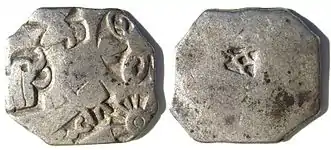
The empire built a strong economy from a solid infrastructure such as irrigation, temples, mines, and roads.[114][115] Ancient epigraphical evidence suggests Chandragupta, under counsel from Chanakya, started and completed many irrigation reservoirs and networks across the Indian subcontinent to ensure food supplies for the civilian population and the army, a practice continued by his dynastic successors.[103] Regional prosperity in agriculture was one of the required duties of his state officials.[116]
The strongest evidence of infrastructure development is found in the Junagadh rock inscription of Rudradaman in Gujarat, dated to about 150 CE. It states, among other things, that Rudradaman repaired and enlarged the reservoir and irrigation conduit infrastructure built by Chandragupta and enhanced by Asoka.[117] Chandragupta's empire also built mines, manufacturing centres, and networks for trading goods. His rule developed land routes to transport goods across the Indian subcontinent. Chandragupta expanded "roads suitable for carts" as he preferred those over narrow tracks suitable for only pack animals.[118]
According to Kaushik Roy, the Maurya dynasty rulers were "great road builders".[115] The Greek ambassador Megasthenes credited this tradition to Chandragupta after the completion of a thousand-mile-long highway connecting Chandragupta's capital Pataliputra in Bihar to Taxila in the north-west where he studied. The other major strategic road infrastructure credited to this tradition spread from Pataliputra in various directions, connecting it with Nepal, Kapilavastu, Dehradun, Mirzapur, Odisha, Andhra, and Karnataka.[115] Roy stated this network boosted trade and commerce, and helped move armies rapidly and efficiently.[115]
Chandragupta and Chanakya seeded weapon manufacturing centres, and kept them as a state monopoly of the state. The state, however, encouraged competing private parties to operate mines and supply these centres.[125] They considered economic prosperity essential to the pursuit of dharma (virtuous life) and adopted a policy of avoiding war with diplomacy yet continuously preparing the army for war to defend its interests and other ideas in the Arthashastra.[126][127]
Arts and architecture
The evidence of arts and architecture during Chandragupta's time is mostly limited to texts such as those by Megasthenes and Kautilya. The edict inscriptions and carvings on monumental pillars are attributed to his grandson Ashoka. The texts imply the existence of cities, public works, and prosperous architecture but the historicity of these is in question.[128]
Archeological discoveries in the modern age, such as those Didarganj Yakshi discovered in 1917 buried beneath the banks of the Ganges suggest exceptional artisanal accomplishment.[120][121] The site was dated to 3rd century BCE by many scholars[120][121] but later dates such as the Kushan era (1st-4th century CE) have also been proposed. The competing theories state that the art linked to Chandragupta Maurya's dynasty was learnt from the Greeks and West Asia in the years Alexander the Great waged war; or that these artifacts belong to an older indigenous Indian tradition.[119] Frederick Asher of the University of Minnesota says "we cannot pretend to have definitive answers; and perhaps, as with most art, we must recognize that there is no single answer or explanation".[129]
Succession, renunciation, and death (Sallekhana)
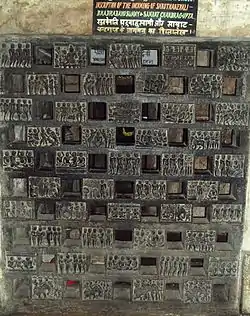
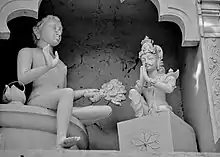
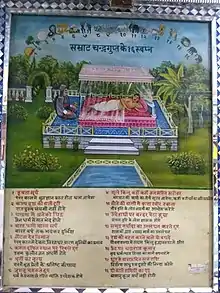
The circumstances and year of Chandragupta's death are unclear and disputed.[2][10][11] According to Digambara Jain accounts that, Bhadrabahu forecasted a 12-year famine because of all the killing and violence during the conquests by Chandragupta Maurya. He led a group of Jain monks to south India, where Chandragupta Maurya joined him as a monk after abdicated his kingdom to his son Bindusara. Together, states a Digambara legend, Chandragupta and Bhadrabahu moved to Shravanabelagola, in present-day south Karnataka.[130] These Jain accounts appeared in texts such as Brihakathā kośa (931 CE) of Harishena, Bhadrabāhu charita (1450 CE) of Ratnanandi, Munivaṃsa bhyudaya (1680 CE) and Rajavali kathe.[131][132][133] Chandragupta lived as an ascetic at Shravanabelagola for several years before fasting to death as per the Jain practice of sallekhana, according to the Digambara legend.[134][26][135]
In accordance with the Digambara tradition, the hill on which Chandragupta is stated to have performed asceticism is now known as Chandragiri hill, and Digambaras believe that Chandragupta Maurya erected an ancient temple that now survives as the Chandragupta basadi.[1] According to Roy, Chandragupta's abdication of throne may be dated to c. 298 BCE, and his death to c. 297 BCE.[59] His grandson was emperor Ashoka who is famed for his historic pillars and his role in helping spread Buddhism outside of ancient India.[136][137]
Regarding the inscriptions describing the relation of Bhadrabahu and Chandragupta Maurya, Radha Kumud Mookerji writes,
The oldest inscription of about 600 AD associated "the pair (yugma), Bhadrabahu along with Chandragupta Muni." Two inscriptions of about 900 AD on the Kaveri near Seringapatam describe the summit of a hill called Chandragiri as marked by the footprints of Bhadrabahu and Chandragupta munipati. A Shravanabelagola inscription of 1129 mentions Bhadrabahu "Shrutakevali", and Chandragupta who acquired such merit that he was worshipped by the forest deities. Another inscription of 1163 similarly couples and describes them. A third inscription of the year 1432 speaks of Yatindra Bhadrabahu, and his disciple Chandragupta, the fame of whose penance spread into other words.[138]
Along with texts, several Digambara Jain inscriptions dating from the 7th–15th century refer to Bhadrabahu and a Prabhacandra. Later Digambara tradition identified the Prabhacandra as Chandragupta, and some modern era scholars have accepted this Digambara tradition while others have not, [2][10][11] Several of the late Digambara inscriptions and texts in Karnataka state the journey started from Ujjain and not Patliputra (as stated in some Digambara texts).[10][11]
Jeffery D. Long – a scholar of Jain and Hindu studies – says in one Digambara version, it was Samprati Chandragupta who renounced, migrated and performed sallekhana in Shravanabelagola. Long states scholars attribute the disintegration of the Maurya empire to the times and actions of Samprati Chandragupta – the grandson of Ashoka and great-great-grandson of Chandragupta Maurya. The two Chandraguptas have been confused to be the same in some Digambara legends.[139]
Scholar of Jain studies and Sanskrit Paul Dundas says the Svetambara tradition of Jainism disputes the ancient Digambara legends. According to a 5th-century text of the Svetambara Jains, the Digambara sect of Jainism was founded 609 years after Mahavira's death, or in 1st-century CE.[140] Digambaras wrote their own versions and legends after the 5th-century, with their first expanded Digambara version of sectarian split within Jainism appearing in the 10th-century.[140] The Svetambaras texts describe Bhadrabahu was based near Nepalese foothills of the Himalayas in 3rd-century BCE, who neither moved nor travelled with Chandragupta Maurya to the south; rather, he died near Patliputra, according to the Svetambara Jains.[10][141][142]
The 12th-century Svetambara Jain legend by Hemachandra presents a different picture. The Hemachandra version includes stories about Jain monks who could become invisible to steal food from royal storage and the Jain Brahmin Chanakya using violence and cunning tactics to expand Chandragupta's kingdom and increase royal revenues.[25] It states in verses 8.415 to 8.435, that for 15 years as king, Chandragupta was a follower of non-Jain "ascetics with the wrong view of religion" (non-Jain) and "lusted for women". Chanakya, who was a Jain follower, persuaded Chandragupta to convert to Jainism by showing that Jain ascetics avoided women and focused on their religion.[25] The legend mentions Chanakya aiding the premature birth of Bindusara,[25] It states in verse 8.444 that "Chandragupta died in meditation (can possibly be sallekhana.) and went to heaven".[143] According to Hemachandra's legend, Chanakya also performed sallekhana. [143]

According to V. R. Ramachandra Dikshitar – an Indologist and historian, several of the Digambara legends mention Prabhacandra, whom had been misidentified as Chandragupta Maurya particularly after the original publication on Shravanabelagola epigraphy by B. Lewis Rice. The earliest and most important inscriptions mention Prabhacandra, which Rice presumed may have been the "clerical name assumed by Chadragupta Maurya" after he renounced and moved with Bhadrabahu from Patliputra. Dikshitar stated there is no evidence to support this and Prabhacandra was an important Jain monk scholar who migrated centuries after Chandragupta Maurya's death.[2] Other scholars have taken Rice's deduction of Chandragupta Maurya retiring and dying in Shravanabelagola as the working hypothesis, since no alternate historical information or evidence is available about Chandragupta's final years and death.[2]
Legacy
A memorial to Chandragupta Maurya exists on Chandragiri hill in Shravanabelagola, Karnakata.[144] The Indian Postal Service issued a commemorative postage stamp honouring Chandragupta Maurya in 2001.[145]
In popular culture
- Mudrarakshasa is a political drama in Sanskrit by Vishakadatta composed 600 years after the conquest of Chandragupta – probably between 300 CE and 700 CE.[59]
- D. L. Roy wrote a Bengali drama named Chandragupta based on the life of Chandragupta. The story of the play is loosely borrowed from the Puranas and the Greek history.[146]
- Chanakya's role in the formation of the Maurya Empire is the essence of a historical/spiritual novel The Courtesan and the Sadhu by Dr. Mysore N. Prakash.[147]
- Chandragupta is a 1920 Indian silent film about the Mauryan king.[148]
- Chandragupta is a 1934 Indian film directed by Abdur Rashid Kardar.
- Chandraguptha Chanakya is an Indian Tamil-language historical drama film directed by C. K. Sachi, starring Bhavani K. Sambamurthy as Chandragupta.
- Samrat Chandragupta is a 1945 Indian historical film by Jayant Desai.[149]
- Samrat Chandragupt is a 1958 Indian historical fiction film by Babubhai Mistry, a remake of the 1945 film. It stars Bharat Bhushan in the titular role of the emperor.[150]
- The story of Chanakya and Chandragupta was made into a film in Telugu in 1977 titled Chanakya Chandragupta.[151]
- The television series Chanakya is an account of the life and times of Chanakya, based on the play "Mudra Rakshasa" (The Signet Ring of "Rakshasa").[152]
- In 2011, a television series called Chandragupta Maurya was telecast on Imagine TV.[153][154][155]
- In 2016, the television series Chandra Nandini was a fictionalized romance saga.[156]
- In 2018, a television series called Chandragupta Maurya portrays the life of Chandragupta Maurya.[157]
- He is a leader of the Indian civilization in the Civilization VI expansion Rise and Fall and Gathering Storm .[158]
- Popular mobile game Rise of Kingdoms introduced Chandragupta Maurya as a playable character. [159]
Notes
- Some early printed editions of Justin's work wrongly mentioned "Alexandrum" instead of "Nandrum"; this error was corrected in philologist J. W. McCrindle's 1893 translation. In the 20th century, historians Hem Chandra Raychaudhuri and R. C. Majumdar believed "Alexandrum" to be correct reading, and theorized that Justin refers to a meeting between Chandragupta and Alexander the Great ("Alexandrum"). However, this is incorrect: research by historian Alfred von Gutschmid in the preceding century had clearly established that "Nandrum" is the correct reading supported by multiple manuscripts: only a single defective manuscript mentions "Alexandrum" in the margin.[45]
- According to Grainger, Seleucus "must ... have held Aria" (Herat), and furthermore, his "son Antiochos was active there fifteen years later". (Grainger, John D. 1990, 2014. Seleukos Nikator: Constructing a Hellenistic Kingdom. Routledge. p. 109).
References
Citations
- Mookerji 1988, p. 40.
- Dikshitar 1993, pp. 264–266.
- Chandragupta Maurya, Emperor of India Archived 10 March 2018 at the Wayback Machine, Encyclopædia Britannica
- Upinder Singh 2016, p. 330.
- Upinder Singh 2016, p. 331.
- Kosambi, D. D. (1966). "Scientific Numismatics". Scientific American. 214 (2): 106–107. Bibcode:1966SciAm.214b.102K. doi:10.1038/scientificamerican0266-102. JSTOR 24931272., Quote: After his departure, a Hindu king, Chandragupta (called Sandracottus in Greek accounts) extended his rule over the entire northern part of the Indian subcontinent [...]"
- Sachindra Kumar Maity (1983). Cultural Heritage of Ancient India. Abhinav Publications. p. 92. ISBN 978-0-391-02809-8.
Chandragupta I is the earliest Hindu ruler whose inscribed gold coins have been handed down to us.
- Mookerji 1988, pp. 2-14, 229-235.
- Mookerji 1988, pp. 3-14.
- Wiley 2009, pp. 50–52.
- Fleet 1892, pp. 156–162.
- Mookerji 1988, pp. 5-7.
- Upinder Singh 2017, pp. 264–265.
- Mookerji 1988, pp. 7–9.
- Edward James Rapson; Wolseley Haig; Richard Burn; Henry Dodwell; Mortimer Wheeler, eds. (1968). The Cambridge History of India. 4. p. 470.
"His surname Maurya is explained by Indian authorities as mean 'son of Mura,' who is described as concubine of the king.
- Mookerji 1988, pp. 9–11.
- Mookerji 1988, p. 13.
- Mookerji 1988, pp. 15-18.
- note
- Mookerji 1988, pp. 7–13.
- Mookerji 1988, p. 14.
- Mookerji 1988, pp. 13-15.
- Thapar 1961, p. 12.
- Mookerji 1988, pp. 13-14.
- Hemacandra 1998, pp. 155–157, 168–188.
- Jones & Ryan 2006, p. xxviii.
- Kulke & Rothermund 2004, p. 59-65.
- Jaini 1991, pp. 43–44.
- Upādhye 1977, pp. 272–273.
- Raychaudhuri 1923, p. 142.
- Raychaudhuri 1923, p. 137.
- Raychaudhuri 1923, p. 138.
- Thapar 1961, p. 13.
- Raychaudhuri 1967, pp. 134–142.
- Habib & Jha 2004, p. 15.
- Damodar Dharmanand Kosambi (1977). D. D. Kosambi Commemoration Volume. D. D. Kosambi Commemoration Committee, Banaras Hindu University : can be had from the Department of Ancient Indian History, Culture & Archaeology, Banaras Hindu University.
- Mookerji 1988, p. 16.
- Raychaudhuri 1967, p. 143.
- Mookerji 1988, p. 6.
- Mookerji 1988, pp. 15–17.
- Modelski, George (1964). "Kautilya: Foreign Policy and International System in the Ancient Hindu World". American Political Science Review. Cambridge University Press. 58 (3): 549–560. doi:10.2307/1953131. JSTOR 1953131.; Quote: "Kautilya is believed to have been Chanakya, a Brahmin who served as Chief Minister to Chandragupta (321–296 B.C.), the founder of the Mauryan Empire."
- Mookerji 1988, pp. 19–20.
- Mookerji 1988, p. 18.
- Habib & Jha 2004, p. 14.
- Trautmann 1970, pp. 240-241.
- Mookerji 1988, p. 32.
- Mookerji 1988, p. 22.
- Hemacandra 1998, pp. 175–188.
- Raychaudhuri 1967, pp. 144-145.
- Raychaudhuri 1967, p. 144.
- Mookerji 1988, p. 33.
- Malalasekera 2002, p. 383.
- Mookerji 1988, pp. 33-34.
- Stoneman 2019, p. 155.
- Thapar 2013, pp. 362–364.
- Sen 1895, pp. 26–32.
- Mookerji 1988, pp. 28–33.
- Roy 2012, pp. 27, 61-62.
- Roy 2012, pp. 61–62.
- Grant 2010, p. 49.
- Bhattacharyya 1977, p. 8.
- Hemacandra 1998, pp. 176–177.
- Mookerji 1988, p. 34.
- Roy 2012, p. 62.
- Mookerji 1988, pp. 2, 25-29.
- Sastri 1988, p. 26.
- Mookerji 1988, pp. 6-8, 31-33.
- Boesche 2003, pp. 9–37.
- Mookerji 1988, pp. 2-3, 35-38.
- Appian, p. 55.
- Mookerji 1988, pp. 36–37, 105.
- Walter Eugene, Clark (1919). "The Importance of Hellenism from the Point of View of Indic-Philology". Classical Philology. 14 (4): 297–313. doi:10.1086/360246.
- "Strabo 15.2.1(9)". Archived from the original on 3 February 2009. Retrieved 14 July 2017.
- Barua 2005, pp. 13-15.
- Thomas McEvilley, "The Shape of Ancient Thought", Allworth Press, New York, 2002, ISBN 1581152035, p.367
- India, the Ancient Past, Burjor Avari, p. 106-107
- Majumdar 2003, p. 105.
- Tarn, W. W. (1940). "Two Notes on Seleucid History: 1. Seleucus' 500 Elephants, 2. Tarmita". The Journal of Hellenic Studies. 60: 84–94. doi:10.2307/626263. JSTOR 626263.
- Mookerji 1988, p. 38.
- Raychaudhuri 1967, p. 18.
- Zvelebil 1973, pp. 53-54.
- Mookerji 1988, pp. 41–42.
- Upinder Singh 2016, pp. 330–331.
- Raychaudhuri 1967, p. 139.
- Thapar 2004, p. 177.
- Arora, U. P. (1991). "The Indika of Megasthenes — an Appraisal". Annals of the Bhandarkar Oriental Research Institute. 72/73 (1/4): 307–329. JSTOR 41694901.
- Roy, Raja Ram Mohan (24 November 2015). India before Alexander: A New Chronology. Mount Meru publishing.
- Arya, Vedveer (24 January 2020). The Chronology of India: From Mahabharata to Medieval Era - Vol I. Aryabhata Publications.
- Raychaudhuri 1967, pp. 139-140.
- Raychaudhuri 1967, p. 140.
- Kulke & Rothermund 2004, p. 61.
- Dupree 2014, pp. 285–289.
- Dupont-Sommer, André (1970). "Une nouvelle inscription araméenne d'Asoka trouvée dans la vallée du Laghman (Afghanistan)". Comptes rendus des séances de l'Académie des Inscriptions et Belles-Lettres. 114 (1): 158–173. doi:10.3406/crai.1970.12491.
- Salomon 1998, pp. 194, 199–200 with footnote 2.
- Habib & Jha 2004, p. 19.
- Kulke & Rothermund 2004, p. 64.
- Boesche 2003, p. 7-18.
- Mookerji 1988, pp. 1-4.
- Mookerji 1988, pp. 13–18.
- Boesche 2003, pp. 7–18.
- MV Krishna Rao (1958, Reprinted 1979), Studies in Kautilya, 2nd Edition, OCLC 551238868, ISBN 978-8121502429, pages 13–14, 231–233
- Olivelle 2013, pp. 31–38.
- Allchin & Erdosy 1995, pp. 187–194.
- Modelski, George (1964). "Kautilya: Foreign Policy and International System in the Ancient Hindu World". American Political Science Review. 58 (3): 549–560. doi:10.2307/1953131. JSTOR 1953131.; Quote: "Kautilya is believed to have been Chanakya, a Brahmin who served as Chief Minister to Chandragupta (321–296 B.C.), the founder of the Mauryan Empire."
- Upinder Singh 2017, p. 220.
- Allchin & Erdosy 1995, pp. 189–192.
- Eraly 2002, pp. 414–415.
- Sastri 1988, pp. 163–164.
- Mookerji 1988, pp. 62–63, 79–80, 90, 159–160.
- Sastri 1988, pp. 120–122.
- Allan 1958, pp. 25–28.
- Obeyesekere 1980, pp. 137–139 with footnote 3.
- Albinski 1958, pp. 62–75.
- Allchin & Erdosy 1995, pp. 187–195.
- Roy 2012, pp. 62–63.
- Allchin & Erdosy 1995, pp. 192–194.
- Allchin & Erdosy 1995, p. 189.
- Allchin & Erdosy 1995, pp. 194–195.
- Guha-Thakurta 2006, pp. 58–61.
- Guha-Thakurta 2006, pp. 51–53, 58–59.
- Varadpande 2006, pp. 32–34 with Figure 11.
- Upinder Singh 2016, p. 364.
- Mandal 2003, p. 46.
- Brown & Hutton 2015, p. 435.
- Roy 2012, pp. 63–64.
- Roy 2012, pp. 64–68.
- Olivelle 2013, pp. 49–51, 99–108, 277–294, 349–356, 373–382.
- Harrison 2009, pp. 234–235.
- Asher 2015, pp. 421–423.
- Habib & Jha 2004, p. 20.
- Mookerji 1988, pp. 39–40.
- Samuel 2010, pp. 60.
- Thapar 2004, p. 178.
- Mookerji 1988, pp. 39–41, 60–64.
- Bentley 1993, pp. 44–46.
- Mookerji 1962, pp. 60–64.
- Bentley 1993, pp. 44-46.
- Mookerji, Radhakumud (1966). Chandragupta Maurya and His Times. Motilal Banarsidass Publ. ISBN 978-81-208-0405-0.
- Long 2013, pp. 60–61.
- Dundas 2003, pp. 46–49.
- Dundas 2003, pp. 46–49, 67–69.
- Jyoti Prasad Jain 2005, pp. 65–67.
- Hemacandra 1998, pp. 185–188.
- Vallely 2018, pp. 182–183.
- Commemorative postage stamp on Chandragupta Maurya Archived 27 April 2013 at the Wayback Machine, Press Information Bureau, Govt. of India
- Ghosh 2001, pp. 44–46.
- The Courtesan and the Sadhu, A Novel about Maya, Dharma, and God, October 2008, Dharma Vision LLC., ISBN 978-0-9818237-0-6, Library of Congress Control Number: 2008934274
- Bhagwan Das Garga (1996). So Many Cinemas: The Motion Picture in India. Eminence Designs. p. 43. ISBN 978-81-900602-1-9.
- Screen World Publication's 75 Glorious Years of Indian Cinema: Complete Filmography of All Films (silent & Hindi) Produced Between 1913-1988. Screen World Publication. 1988. p. 109.
- Hervé Dumont (2009). L'Antiquité au cinéma: vérités, légendes et manipulations. Nouveau Monde. ISBN 978-2-84736-476-7.
- "Chanakya Chandragupta (1977)". IMDb. Archived from the original on 11 March 2016. Retrieved 20 February 2016.
- "Television". The Indian Express. 8 September 1991. Archived from the original on 11 May 2018. Retrieved 22 August 2017.
- "Chandragupta Maurya comes to small screen". Zee News. 13 January 2011. Archived from the original on 3 March 2016.
- "Chandragupta Maurya on Sony TV?". The Times of India. Archived from the original on 4 January 2016.
- TV, Imagine. "Channel". TV Channel. Archived from the original on 25 July 2011.
- "Real truth behind Chandragupta's birth, his first love Durdhara and journey to becoming the Mauryan King". 17 October 2016. Archived from the original on 28 October 2017.
- "'Chandraguta Maurya' to launch in November on Sony TV". Archived from the original on 13 November 2018. Retrieved 18 November 2018.
- "Civilization VI – The Official Site | News | CIVILIZATION VI: RISE AND FALL - CHANDRAGUPTA LEADS INDIA". civilization.com. Archived from the original on 27 July 2018. Retrieved 26 July 2018.
- "Chandragupta Maurya Commander Guide: Skills, Pairs 2020".
Sources
- Albinski, Henry S. (1958), "The Place of the Emperor Asoka in Ancient Indian Political Thought", Midwest Journal of Political Science, 2 (1): 62–75, doi:10.2307/2109166, JSTOR 2109166
- Allan, J (1958), The Cambridge Shorter History Of India, Cambridge University Press
- Allchin, F. R.; Erdosy, George (1995), The Archaeology of Early Historic South Asia: The Emergence of Cities and States, Cambridge University Press, ISBN 978-0-521-37695-2
- Appian, History of Rome, The Syrian Wars
- Asher, Frederick (2015), Brown, Rebecca M.; Hutton, Deborah S. (eds.), A Companion to Asian Art and Architecture, John Wiley & Sons, ISBN 978-1-119-01953-4
- Barua, Pradeep (2005), The State at War in South Asia, 2, Nebraska Press, ISBN 9780803240612,
via Project MUSE (subscription required)
- Bentley, Jerry (1993), Old World Encounters: Cross-Cultural Contacts and Exchanges in Pre-Modern Times, Oxford University Press
- Bhattacharyya, P. K. (1977), Historical Geography of Madhyapradesh from Early Records, Motilal Banarsidass
- Boesche, Roger (2003), "Kautilya's Arthaśāstra on War and Diplomacy in Ancient India" (PDF), The Journal of Military History, 67 (1): 9, doi:10.1353/jmh.2003.0006, ISSN 0899-3718, S2CID 154243517
- Brown, Rebecca M.; Hutton, Deborah S. (22 June 2015), A Companion to Asian Art and Architecture, John Wiley & Sons, ISBN 9781119019534
- Dikshitar, V. R. Ramachandra (1993), The Mauryan Polity, Motilal Banarsidass Publ., ISBN 978-81-208-1023-5
- Dundas, Paul (2003), The Jains, Routledge, ISBN 978-0-415-26605-5
- Dupree, Louis (2014), Afghanistan, Princeton University Press, ISBN 978-1-4008-5891-0
- Eraly, Abraham (2002), Gem In The Lotus, Penguin, ISBN 978-93-5118-014-2
- Fleet, J.F. (1892), Bhadrabahu, Chandragupta and Shravanabelagola (Indian Antiquary), 21, Archaeological Society of India
- Ghosh, Ajit Kumar (2001), Dwijendralal Ray, Makers of Indian Literature (1st ed.), New Delhi: Sahitye Akademi, ISBN 978-81-260-1227-5
- Grant, R.G. (2010), Commanders, Penguin
- Guha-Thakurta, Tapati (2006), Chatterjee, Partha; Ghosh, Anjan (eds.), History and the Present, Anthem Press, ISBN 978-1-84331-224-6
- Habib, Irfan; Jha, Vivekanand (2004), Mauryan India, A People's History of India, Aligarh Historians Society / Tulika Books, ISBN 978-81-85229-92-8
- Harrison, Thomas (2009), The Great Empires of the Ancient World, Getty Publications, ISBN 978-0-89236-987-4
- Hemacandra (1998), The Lives of the Jain Elders, translated by R.C.C. Fynes, Oxford University Press, ISBN 978-0-19-283227-6
- Jain, Jyoti Prasad (2005), Jaina Sources of the History of Ancient India: 100 BC - AD 900, Munshiram Manoharlal
- Jaini, Padmanabh S. (1991), Gender and Salvation, University of California Press, ISBN 978-0-520-06820-9
- Jones, Constance; Ryan, James D. (2006), Encyclopedia of Hinduism, Infobase Publishing, ISBN 978-0-8160-7564-5
- Long, Jeffery D (2013), Jainism: An Introduction, I.B.Tauris, ISBN 978-0-85771-392-6
- Kulke, Hermann; Rothermund, Dietmar (2004), A History of India (4th ed.), London: Routledge, ISBN 978-0-415-15481-9
- Majumdar, R. C. (2003) [1952], Ancient India, Motilal Banarsidass, ISBN 978-81-208-0436-4
- Malalasekera, Gunapala Piyasena (2002), Encyclopaedia of Buddhism: Acala, Government of Ceylon
- Mandal, Dhaneshwar (2003), Ayodhya, Archaeology After Demolition: A Critique of the "new" and "fresh" Discoveries, Orient Blackswan, ISBN 9788125023449
- Mookerji, Radha Kumud (1962), Aśoka (3rd Revised., repr ed.), Delhi: Motilal Banarsidass (reprint 1995), ISBN 978-81208-058-28
- Mookerji, Radha Kumud (1988) [first published in 1966], Chandragupta Maurya and his times (4th ed.), Motilal Banarsidass, ISBN 81-208-0433-3
- Obeyesekere, Gananath (1980), Doniger, Wendy (ed.), Karma and Rebirth in Classical Indian Traditions, University of California Press, ISBN 978-0-520-03923-0
- Olivelle, Patrick (2013), King, Governance, and Law in Ancient India: Kauṭilya's Arthaśāstra, Oxford UK: Oxford University Press, ISBN 978-0199891825
- Raychaudhuri, H. C. (1923), Political History of Ancient India: From the Accession of Parikshit to the Extinction of the Gupta Dynasty, Oxford University Press (1996 reprint, with B. N. Mukerjee Introduction)
- Raychaudhuri, H. C. (1967), "India in the Age of the Nandas / Chandragupta and Bindusara", in K. A. Nilakanta Sastri (ed.), Age of the Nandas and Mauryas (Second ed.), Motilal Banarsidass (1988 reprint), ISBN 978-81-208-0466-1
- Roy, Kaushik (2012), Hinduism and the Ethics of Warfare in South Asia: From Antiquity to the Present, Cambridge University Press, ISBN 978-1-107-01736-8
- Salomon, Richard (1998), Indian Epigraphy: A Guide to the Study of Inscriptions in Sanskrit, Prakrit, and the other Indo-Aryan Languages, Oxford University Press, ISBN 978-0-19-535666-3
- Samuel, Geoffrey (2010), The Origins of Yoga and Tantra. Indic Religions to the Thirteenth Century, Cambridge University Press
- Sastri, Kallidaikurichi Aiyah Nilakanta (1988), Age of the Nandas and Mauryas, Motilal Banarsidass, ISBN 978-81-208-0466-1
- Sen, R.K. (1895), "Origin of the Maurya of Magadha and of Chanakya", Journal of the Buddhist Text Society of India, The Society
- Singh, Upinder (2016), A History of Ancient and Early Medieval India: From the Stone Age to the 12th Century, Pearson Education, ISBN 978-93-325-6996-6
- Singh, Upinder (2017), Political Violence in Ancient India, Harvard University Press, ISBN 978-0-674-97527-9
- Stoneman, Richard (2019), The Greek Experience of India: From Alexander to the Indo-Greeks, Princeton University Press, ISBN 978-0-691-18538-5
- Thapar, Romila (1961), Aśoka and the Decline of the Mauryas, Oxford University Press
- Thapar, Romila (2004) [first published by Penguin in 2002], Early India: From the Origins to A.D. 1300, University of California Press, ISBN 978-0-520-24225-8
- Thapar, Romila (2013), The Past Before Us, Harvard University Press, ISBN 978-0-674-72651-2
- Trautmann, Thomas R. (1970), "Alexander and Nandrus in Justin 15.4.16.", Annals of the Bhandarkar Oriental Research Institute, 51 (1/4)
- Upādhye, Ādinātha Neminātha (1977), Mahāvīra and His Teachings, Bhagavān Mahāvīra 2500th Nirvāṇa Mahotsava Samiti
- Vallely, Anne (2018), Kitts, Margo (ed.), Martyrdom, Self-Sacrifice, and Self-Immolation: Religious Perspectives on Suicide, Oxford University Press, ISBN 978-0-19-065648-5
- Varadpande, Manohar Laxman (2006), Woman in Indian Sculpture, Abhinav, ISBN 978-81-7017-474-5
- Wiley, Kristi L. (16 July 2009), The A to Z of Jainism, Scarecrow, ISBN 978-0-8108-6821-2
- Zvelebil, Kamil (1973), The Smile of Murugan: On Tamil Literature of South India, BRILL, ISBN 90-04-03591-5
Further reading
| Library resources about Chandragupta Maurya |
- Bongard-Levin, Grigory Maksimovich (1985). Mauryan India. New Delhi: Sterling Publishers. OCLC 14395730.
- Kosmin, Paul J. (2014), The Land of the Elephant Kings: Space, Territory, and Ideology in Seleucid Empire, Harvard University Press, ISBN 978-0-674-72882-0
- Mani, Braj Ranjan (2005), Debrahmanising history: dominance and resistance in Indian society, Manohar, ISBN 978-81-7304-640-7
- Roy, Kaushik (2015), Warfare in Pre-British India–1500BCE to 1740CE, Routledge
- Sagar, Krishna Chandra (1992), Foreign Influence on Ancient India, Northern Book Centre, ISBN 9788172110284
External links
| Wikimedia Commons has media related to Chandragupta Maurya. |
| Wikiquote has quotations related to: Chandragupta Maurya |
- Maurya and Sunga Art, N R Ray

